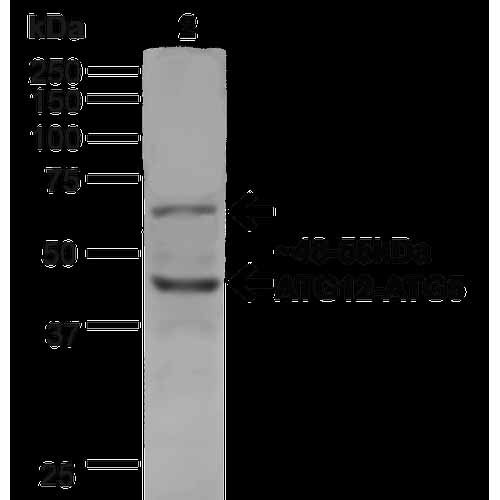ATG12 Antibody
- SPECIFICATION
- CITATIONS
- PROTOCOLS
- BACKGROUND

Application
| WB, ICC |
|---|---|
| Primary Accession | O94817 |
| Other Accession | NP_001264712.1 |
| Host | Rabbit |
| Reactivity | Human |
| Clonality | Polyclonal |
| Description | Rabbit Anti-Human ATG12 Polyclonal |
| Target/Specificity | Predicted molecular weight at ~15.1kDa. Observed molecular weights at ~48-55kDa based on ATG12-ATG5 heterodimer. |
| Other Names | APG12-like Antibody, APG12 Antibody, ATG12_Human Antibody, HAPG12 Antibody, FBR93 Antibody |
| Immunogen | Synthetic peptide from the N-terminal of human ATG12 |
| Purification | Peptide Affinity Purified |
| Storage | -20ºC |
| Storage Buffer | PBS, 50% glycerol, 0.09% sodium azide |
| Shipping Temperature | Blue Ice or 4ºC |
| Certificate of Analysis | A 1:1000 dilution of SPC-607 was sufficient for detection of ATG12 on HeLa cell lysates using Goat anti-rabbit IgG:HRP as the secondary antibody. |
| Cellular Localization | Cytoplasm |

Thousands of laboratories across the world have published research that depended on the performance of antibodies from Abcepta to advance their research. Check out links to articles that cite our products in major peer-reviewed journals, organized by research category.
info@abcepta.com, and receive a free "I Love Antibodies" mug.
Provided below are standard protocols that you may find useful for product applications.
Background
ATG12 (autophagy-related protein 12), also known as APG12, is a 140 amino acid protein that is ubiquitously expressed and belongs to the ATG12 family of proteins. ATG12 is a homolog of the yeast protein APG12 that participates in autophagy. Autophagy is a membrane trafficking mechanism that delivers cytoplasmic cargo to the vacuole/lysosome for degradation and recycling. In yeast, autophagy requires a protein conjugation system consisting of APG12 covalently bound at the carboxy terminal glycine to lysine 149 of APG5. Similarly in humans, ATG12 is essential for autophagy and localizes to the cytoplasm where it is covalently bound to APG5, a conjugation reaction that requires APG7, ATG10 and ATP (1-3). The ATG12-APG5 conjugate functions as an important regulator of the autophagic process and is required for the change in membrane morphology and development of autophagosomes. Due to alternative splicing events, two ATG12 isoforms exist.
References
1. Mizushima N., Sugita H., Yoshimori T., Ohsumi Y. (1999) J Biol Chem. 273(51): 33889-33892.
2. Mizushuma N., et al. (1998) Nature. 395: 395-398.
3. Suzuki K., et al. (2001) EMBO J. 20: 5971-5981.
If you have used an Abcepta product and would like to share how it has performed, please click on the "Submit Review" button and provide the requested information. Our staff will examine and post your review and contact you if needed.
If you have any additional inquiries please email technical services at tech@abcepta.com.













 Foundational characteristics of cancer include proliferation, angiogenesis, migration, evasion of apoptosis, and cellular immortality. Find key markers for these cellular processes and antibodies to detect them.
Foundational characteristics of cancer include proliferation, angiogenesis, migration, evasion of apoptosis, and cellular immortality. Find key markers for these cellular processes and antibodies to detect them. The SUMOplot™ Analysis Program predicts and scores sumoylation sites in your protein. SUMOylation is a post-translational modification involved in various cellular processes, such as nuclear-cytosolic transport, transcriptional regulation, apoptosis, protein stability, response to stress, and progression through the cell cycle.
The SUMOplot™ Analysis Program predicts and scores sumoylation sites in your protein. SUMOylation is a post-translational modification involved in various cellular processes, such as nuclear-cytosolic transport, transcriptional regulation, apoptosis, protein stability, response to stress, and progression through the cell cycle. The Autophagy Receptor Motif Plotter predicts and scores autophagy receptor binding sites in your protein. Identifying proteins connected to this pathway is critical to understanding the role of autophagy in physiological as well as pathological processes such as development, differentiation, neurodegenerative diseases, stress, infection, and cancer.
The Autophagy Receptor Motif Plotter predicts and scores autophagy receptor binding sites in your protein. Identifying proteins connected to this pathway is critical to understanding the role of autophagy in physiological as well as pathological processes such as development, differentiation, neurodegenerative diseases, stress, infection, and cancer.



